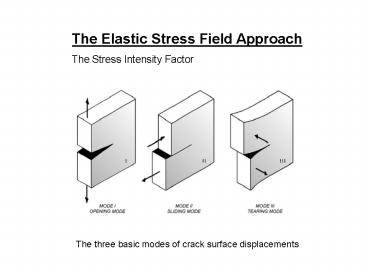The Elastic Stress Field Approach - PowerPoint PPT Presentation
1 / 36
Title:
The Elastic Stress Field Approach
Description:
The Elastic Stress Field Approach The Stress Intensity Factor The three basic modes of crack surface displacements * * * * SPECIMENS Increasing or decreasing K ... – PowerPoint PPT presentation
Number of Views:136
Avg rating:3.0/5.0
Title: The Elastic Stress Field Approach
1
The Elastic Stress Field Approach The Stress
Intensity Factor
The three basic modes of crack surface
displacements
2
Derivation of the Elastic Stress Field Equations
- Concepts of plane stress and plane strain
- Equilibrium equations
- Compatibility equations for strains
- Airy stress function
- Biharmonic equation
- Complex stress functions Westergaard function
for biaxially loaded plate (Mode I) - Mode I stress / displacement fields
- Mode I stress intensity factor
Westergard (1939), Irwin (1957)
3
Linear Elastic Crack-tip Fields (general case)
4
(No Transcript)
5
CHARACTERISTICS OF THE STRESS FIELDS
- Details of the applied loading enters only
through K !!! - for the infinite plate K s(pa)1/2
- But for a given Mode there is a characteristic
shape of the field !!!
- Principle of Superposition for a given Mode, K
terms from superposed loadings are additive
6
We consider next some other cases apart from the
cracked infinite plate
- Semi infinite edge notched specimens
- Finite width centre cracked specimens
- Finite width edge notched specimens
- Crack-line loading
- Elliptical / Semielliptical cracks
7
Finite-width centre-craked specimens
8
Single edge notched (SEN)
Double edge notched (DEN)
SEN
Finite-width edge-notched specimens
0.5 accurate for a/W lt 0.6
DEN
0.5 accurate for any a/W
9
TWO IMPORTANT SOLUTIONS FOR PRACTICAL USE
Crack-line Loading (P force per unit thickness)
for centrally located force
KI decrease when crack length increases !
- Very useful solution
- Riveted, bolted plates
- Internal Pressure problems
10
Elliptical Cracks
We start considering idealised situations from
embeded elliptical crack to semielliptical
surface cracks
11
The embeded (infinite plate) elliptical crack
under Mode I loading
a/c 0.0 0.1 0.2 0.3 0.4 0.5 0.6 0.7 0.8 0.9 1.0
F 1.000 1.016 1.051 1.097 1.151 1.211 1.277 1.345 1.418 1.493 1.571
12
The semi- elliptical surface crack in a plate of
finite dimensions under Mode I loading
In practice elliptical cracks will generally
occur as semi-elliptical surface cracks or
quarter-elliptical corner cracks Best solutions
for semielliptical FEM calculations from
Raju-Newman
13
SUPERPOSITION OF STRESS INTENSITY FACTORS
1) Crack under Internal Pressure
14
3) Cracks growing from both sidesof a loaded hole
where the hole is small with respect to the crack
where P is the force per unit thickness
15
CRACK TIP PLASTICITY
16
First Order Aproximations of Plastic Zone Shapes
- Empirical Rules to estimating Plane Stress vs.
Plane Strain conditions - Plane Stress 2.ry B
- Plane Strain 2.ry lt 1/10 B
17
Planes of maximum shear stress location of the
planes of maximum shear stress at the tip of the
crack for plane stress (a) and plane strain (b)
conditions
18
Deformation Modes plane strain (a) and plane
stress (b)
19
FRACTURE TOUGHNESS
Is K a useful parameter to characterise fracture
toughness?
KIC is a material property fracture toughness of
linear elastic materials
20
Remember Empirical Rules to estimate Plane
Strain conditions 2ry lt 1/10 B
21
LEFM Testing ASTM E-399, committee E8 Fatigue
and Fracture Fatigue pre-cracked specimens !
22
(No Transcript)
23
Material Toughness Anisotropy
To provide a common scheme for describing
material anisotropy, ASTM standardized the
following six orientations L-S, L-T, S-L, S-T,
T-L, and T-S. The first letter denotes the
direction of the applied load the second letter
denotes the direction of crack growth. In
designing for fracture toughness, consideration
of anisotropy is very important, as different
orientations can result in widely differing
fracture-toughness values.
When the crack plane is parallel to the rolling
direction, segregated impurities and
intermetallics that lie in these planes represent
easy fracture paths, and the toughness is low.
When the crack plane is perpendicular to these
weak planes, decohesion and crack tip blunting or
stress reduction occur, effectively toughening
the material. On the other hand, when the crack
plane is parallel to the plane of these defects,
toughness is reduced because the crack can
propagate very easily.
24
SUBCRITICAL CRACK PROPAGATION IN COMPONENTS WITH
PREXISTING FLAWS
Fatigue
- Sustained load crack growth behaviour
- - stress corrosion cracking
- cracking due to embrittlement by internal or
external gaseous hydrogen - liquid metal embrittlement
- creep and creep crack growth
25
Fatigue Crack Propagation
26
How to describe crack growth rate curves crack
growth laws
27
EXAMPLES of Crack Growth rate Behaviour
28
Effect of R
Influence of R on fatigue crack growth in Al
2024-T3 Alclad sheet
CRACK CLOSURE
29
Crack closure effects
30
(No Transcript)
31
Closure Mechanisms
32
Sustained load crack growth behaviour
Time to Failure Tests
preferred technique in the past
33
Generalised sustained load crack growth behaviour
Modern techniques based on fracture mechanics
parameter K !
34
SPECIMENS Increasing or decreasing K specimens
crack- line wedge-loaded specimen (CLWL)
tapered double cantilever beam-specimen (TDCB)
constant K !!!
bolt loaded cantilever beam-specimen (DCB)
35
Difference in crack growth behaviour for
increasing K (cantilever beam) and decreasing K
(modified CLWL or DCB specimens)
Entire crack growth with one specimen Self
stressed and portable Claer steady state and
arrest
Corrosion product wedging gives higher crack
growth rate at a given nominal KI.
Disadvantages
36
Example
Outdoor exposure stress corrosion cracking
propagation in 7000 series Al-alloy plate































